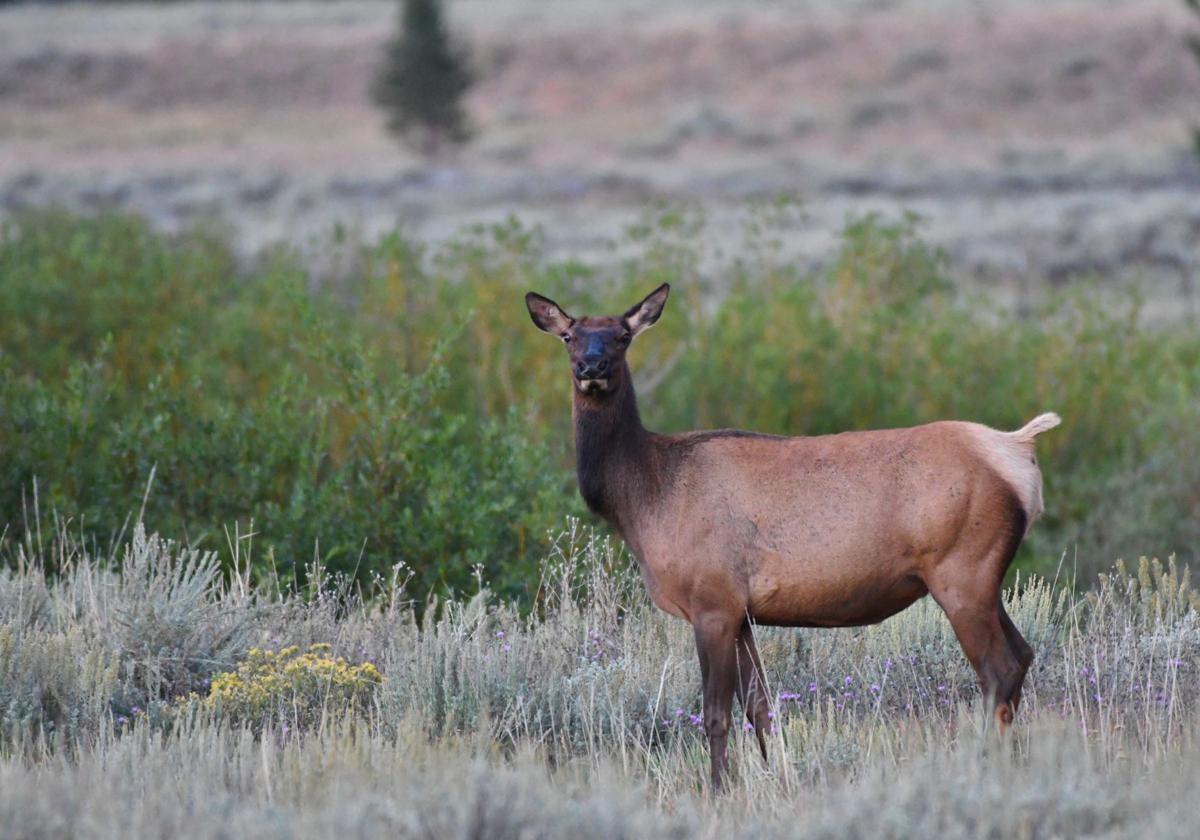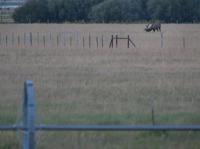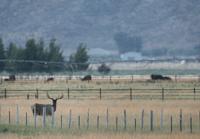
A cow elk grazes at dawn in Blaine County last summer. Idaho Fish and Game says its offering more depredation hunts this year so that sportsmen can help the department keep elk from damaging crops.
TWIN FALLS — Last year, Idaho Fish and Game killed 206 elk in an effort to prevent the animals from eating thousands of dollars worth of crops.
Many Magic Valley hunters were outraged by those killings for a handful of reasons. A large portion of hunters said they felt Fish and Game should have used sportsmen to harvest the elk instead of having staff remove the animals with nighttime sharpshooting.

A bull elk grazes on an irrigated pasture at dusk Thursday in Blaine County. Fish and Game is continuing its efforts this summer to keep elk off of ag land.
Fish and Game is required by state statute to refund ag producers for losses caused by big game. Elk are still eating crops this year, as they always have, and Fish and Game is still working to prevent crop losses.
But this summer, the department is trying to be more transparent with the public about what it’s doing to prevent depredations.
The night problem
When an elk grazes on a farmer’s alfalfa field, Idaho law allows that farmer to file a claim with Fish and Game in order to receive compensation for crop damages.
In the past few years, the Magic Valley’s elk population has grown, and with that growth the number of depredation claims has risen. In 2015, Idaho Fish and Game’s Magic Valley region paid out $69,000 in depredation claims. Just three years later in 2018, the number of claims tripled here and the total cost exceeded $1.5 million.
In a few instances, hundreds of elk have descended on one ag field — Fish and Game had to pay $1.1 million for one Magic Valley claim in 2018. With the burden of depredation claim payouts becoming extreme, Fish and Game began looking for new methods to limit crop damage.
The wildlife department tried a handful of methods to prevent elk from eating crops. They’ve tried using dogs to chase elk out of cornfields and spraying crops on the edges of fields so that they taste bad. Occasionally they’ve tried fencing. Another common approach involves making loud noises or flashing lights to scare the elk away.
None of the department’s non-lethal methods has been all that successful, Idaho Fish and Game Magic Valley Region Landowner and Sportsmen Coordinator John Guthrie said. Elk are smart, and they learn quickly. They remember the loud noises didn’t actually hurt them, or they discover only the edge of the field was sprayed with something nasty.
So three years ago, Guthrie decided to test a new approach, which he studied as part of his graduate research at the University of Idaho: sharpshooting. He wanted to answer the question: If you kill some of the elk that eat crops, will the remaining elk learn to fear that area and stop coming back?
Sharpshooting problem elk brings with it a host of issues. First, elk typically only come into ag fields at night. During the day they return to the relative security of nearby mountains. It’s illegal to hunt at night, so Fish and Game can’t use hunters when sharpshooting is involved. Even if the department could use hunters, it wouldn’t be easy.

A bull elk grazes in an irrigated pasture at dusk Thursday in Blaine County.
“I don’t think a lot of the public has a really firm grasp on how truly difficult (nighttime sharpshooting) is,” Guthrie said.
Each night Fish and Game does nighttime sharpshooting, it takes two people on Guthrie’s team 12 hours, from 6 p.m. to 6 a.m.
“It’s way easier for us to use hunters, physically, than it is for us to go out and do the work ourselves,” Guthrie said.
Hunters have countered that if they were issued depredation tags, they would be more than happy to find elk while they’re on the mountains during the day. But in these instances where Fish and Game is resorting to killing animals, that usually isn’t an option.
That’s because the elk that are eating up crops often spend both their days and nights on private land. Fish and Game can’t unilaterally allow hunters onto private land without landowner permission.
Guthrie said he spends his days working with landowners on these depredation issues. He’s hopeful that there could be more depredation hunts on private land in the future. But right now, many landowners are reluctant — understandably so, Guthrie notes — to allow hunters onto their property.
When elk are eating crops and spending the daylight hours on public land, Fish and Game does issue depredation permits, Guthrie said. Right now Gurthrie said he’s calling up hunters to get people for a depredation hunt for some small ag fields south of the interstate adjacent to a U.S. Forest Service sagebrush plain. It’s way easier to do hunts on that public land, he said.
Guthrie reiterated that using hunters is both preferred and easier.
“By all means that is our first tool that we go to,” he said.
Getting back some results
This summer, Fish and Game has been hazing elk near Little Camas Reservoir. The department also authorized a depredation hunt in mid-July for antlerless elk northeast of Fairfield in an effort to reduce crop damage to alfalfa fields. Since mid-July, Fish and Game has authorized an additional depredation hunt in the Goose Creek area south of Oakley.
One of those hunts was on private land, where the landowner allowed hunters onto their property. Fish and Game staff accompanied the hunters during the hunt to ensure they complied with the landowner’s rules. There have also been kill permits issued to landowners throughout the Magic Valley. Those permits usually allow landowners to take between one to three elk.
It’s brand new for Fish and Game to find a landowner willing to allow hunters onto their property, Guthrie said. This was just the first private-land depredation hunt, he noted, and it was only for two tags. But it’s an important step.
“It was definitely a start,” Guthrie said. “We’re not there yet.”

A bull elk grazes in an irrigated pasture at dusk Thursday in Blaine County.
A hunter’s view
Magic Valley hunter Byrd Golay says he absolutely hates that Fish and Game killed 206 elk last year.
When he heard about the nighttime sharpshooting he was so angry that he began meeting with Fish and Game leaders and organizing large meetings of hunters to discuss the problem. Right now he said he’s working with Sen. Lee Heider (R-Twin Falls) to try and change the state law regarding depredation claims so that Fish and Game can’t kill elk.
“I realize 100% it’s a statute,” Golay said, acknowledging that Fish and Game is legally required to prevent or reimburse depredations. “But the statute was written by ranchers to justify their means so they can get more depredation money.”
Golay says he thinks Fish and Game’s approach to the elk depredation is completely wrong both in terms of morality and effectiveness. Even if nighttime sharpshooting does prove to be effective, Golay said he’s against it from an ethical standpoint. He says the department shouldn’t be killing elk during a time when hunters are struggling to find any.
“It’s not fair to the sportsmen, it’s not fair to the elk and it’s not fair to the public,” Golay said.
The solution should probably involve fencing, Golay said. With elk, fencing has to be unusually tall to be effective. Fish and Game has done some fencing — the department has spent hundreds of thousands of dollars building fencing around haystacks — but Golay said he wants to see them enclose entire ag fields. He explained that he went to D&B Supply this week with Heider to price fencing, and believes it would cost $30,000 a mile.
That would be a better option than nighttime sharpshooting, Golay said.
“If they fence the property and make it so those elk can’t get in there, they will leave,” Golay said. “They will leave.”
Handling the heat
Guthrie said that as of Tuesday, Fish and Game has only killed one elk with nighttime sharpshooting this year. Part of the reason the department has only killed one elk so far could be because last year’s sharpshooting worked.
For instance, last year there was one particular ag field where Fish and Game killed 108 elk — it was the same field that had the $1.1 million claim in 2018.
Based on preliminary radio collar data, it looks like that sharpshooting is an effective deterrent, Guthrie said. A few years ago, hundreds of elk ate crops on that field. This year the maximum has been 70, but lately there have only been about 10.
The early data suggest the elk have changed their behavior because they associate those ag fields with the frightening deaths of their fellow herd members, Guthrie said.
It’s quite possible that Fish and Game could have to use nighttime sharpshooting more as the summer continues — when it gets hotter and native forage plants dry out, elk generally push into ag fields even more. Plus, calves get stronger and more mobile as the summer drags on, so mothers can travel farther distances.
“We do anticipate things to pick up, especially with this hot weather,” Guthrie said. “But the current state is looking pretty good.”
Subscribe to our Daily Headlines newsletter.
August 10, 2020 at 09:00PM
https://ift.tt/3iwF93R
Fish and Game's elk killings seem to be working; hunters want more opportunity to help - Twin Falls Times-News
https://ift.tt/35JkYuc
Fish





No comments:
Post a Comment